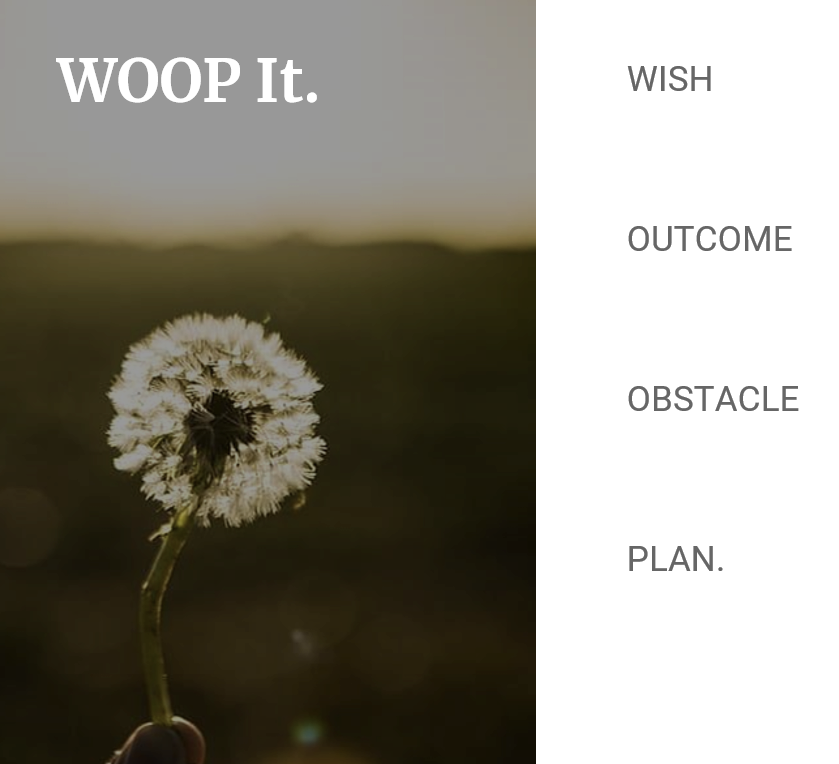Crisis Support
If you’re in crisis, there are options available to help you cope. You can call the National Suicide Prevention Lifeline at any time to speak to someone and get support.
For confidential support available 24/7 for everyone in the U.S., call 1-800-273-8255
For confidential support by county, the state of California has a countywide list of resources and phone numbers.
Self-Care Strategies
 WOOP is a science-based mental strategy that people can use to find and fulfill their wishes, set preferences, and change their habits. Wish Obstacle Conduct a WOOP online right now to get started.
WOOP is a science-based mental strategy that people can use to find and fulfill their wishes, set preferences, and change their habits. Wish Obstacle Conduct a WOOP online right now to get started.
Ask yourself, what do I need right now?
Mind-Body activities can help people tolerate discomfort better, help teach self-regulation, reduce meltdowns, lower stress, and create focus.
When to use: ANY TIME. Other ideas include brain breaks or transition to another activity, throughout the day, either before or after a challenging task.
Breathing techniques
Balloon breath: You can either breathe lying down in a resting position on their back, or sitting up. Practice breathing in deeply and at the same time “fill up a balloon” in their bellies. You may place one hand on your stomach to feel for the balloon. As you breathe out, “deflate the balloon”.
Benefits: Relieve symptoms of stress, trigger the relaxation response
Ocean Breath: Breathe in through your nose and then exhale, opening your mouth and make a “haaaaa” sound, like an ocean wave. You can bein any seated, standing, or resting pose to do this. You may also put your palms together in front and then raise them to the sky as you breathe in and then lower them as you breathe out.
Benefits: Calms the mind, relaxes the neck and lower face
Lion’s Breath: this technique can help discharge extra energy that you may have, especially if you are feeling angry or agitated.
1. Breathe in through the nose, open your mouth, stick out tongue and breathe out forcefully through mouth, making a face like a lion and aloud noise as you force the air out of your lungs.
Benefits: Relieves excess energy, relieves tension in the jaw, neck, and chest
Mindfulness, Grounding, and Breathing Exercise
Close your eyes if you feel comfortable doing so, or you can choose to gaze upon a non-living object. We’re going to start by focusing on our feet if we are sitting in a chair, or your sitz bones if you are seated on the ground. Focus on the sensation you feel as your body connects with the ground. Let go of everything that was on your mind as you came in this morning. We are focused on being present in the moment. I want you to focus next on your breathing. Breathe in through your nose for five seconds and breathe out through your mouth, taking everything insidethat is distracting you out with your breath. As you breathe in, focus on your intention today. This time as you breathe out, breathe out through your nose, and try to breathe out for about 8 seconds. Practice at least three more breaths like this.
Components of Self-Care
- Relationship with yourself: Be connected to your own body and sensations. Notice signs of stress, fatigue, and burnout.
- Community: Find other teachers to connect with that are doing this work that you can connect with
- Boundaries: Cultivate the courage to say no.
- Downtime: Set aside time for hobbies and relaxation.
- Significant relationships: Do you have relationships where you feel supported?
Self-Care and Self-Compassion
A Self-Awareness Practice to Tune-In:
- Look around the room. Move your head to take in your environment, as if you have discovered a new place and you are curious about it. Track your body. Did you take a deep breath just by looking around? Tune into your body and notice what is there. You may close your eyes if you wish.
- What sensations do you feel? Are there areas that feel tight? What’s feeling good? Try to scan your sensations without placing judgment on them. Notice if there is a lack of sensation in any part.
- What emotions do you feel? Are you eager? Are you nervous? Try to scan your emotions without placing judgment on top of them. Just observe, notice yourself.
- Deliberately deepen your breath. Make a sound if you feel like it. Notice what happens as you do.
What we just practiced is called self-awareness.
Orienting and Grounding
Orienting: Sit comfortably in a chair with both feet on the ground. Slowly turn your head and look around at your environment. As you slowly check the room around you, try noticing objects that you find pleasant to look at.
Benefit: Re-orient you if you have a hypervigilant nervous system. Helps relax the body and is good to counteract anxiety, promotes mindfulness practice, and promotes self-regulation.
Grounding: You can do this either walking or sitting. If you are sitting, focus on the feeling of your feet on the floor and how your legs feel, without any judgement. If you are walking, focus on the feeling of your feet touching the ground and the feelings in your legs. This can help those who might feel dissociated to feel secure and empowered again.
Benefit: diminish states of activation in the nervous system, helps focus us back tow here we are instead of in our head space (helpful to people who are or have been impacted by trauma), helps counter dissociation. Research shows that regular grounding practice can help regulate strong emotions such as anger.